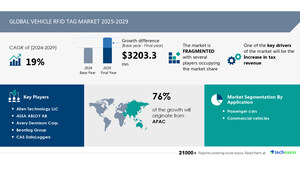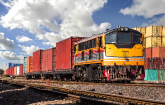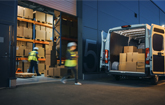NEW YORK, May 21, 2024 /PRNewswire/ -- The rail freight transportation market size in North America is estimated to grow by USD 35.83 billion from 2024-2028, according to Technavio. The market is estimated to grow at a CAGR of 7.45% during the forecast period.
For more insights on the forecast market size and historic data (2018 - 2022) - Download Free sample report in a minutes
Forecast period |
2024-2028 |
Base Year |
2023 |
Historic Data |
2018 - 2022 |
Segment Covered |
Mode Of Transportation (Freight cars, Tank wagons, and Intermodals), End-user (Petroleum and chemical, Coal, Metals and minerals, Agriculture products, and Others), and Geography (North America) |
Region Covered |
North America |
Key companies profiled |
Berkshire Hathaway Inc., Brookfield Business Partners LP, Canadian National Railway Co., Canadian Pacific Kansas City, CSX Corp., DB Schenker, Deutsche Post AG, DSV AS, GeoMetrix Rail Logistics Inc., Grupo Mexico SAB de CV, Harsco Corp., Hub Group Inc., Kerry Logistics Network Ltd., Norfolk Southern Corp., Patriot Rail Co., RSI Logistics Inc., Union Pacific Corp., United Parcel Service Inc., VIA Rail Canada Inc., and WSP Global Inc. |
Key Market Trends Fueling Growth
Rail transportation for freight is highly favored due to its cost-effectiveness and efficiency. It's estimated to be 6-7 times more efficient than driving, reducing pollution by 30% to 80%. Rail transport can move large cargo volumes over extensive distances, making it an economical choice. Major rail carriers like Canadian National (CN) Railway and Canadian Pacific (CP) Railway dominate the transportation of agricultural products across the Canadian Prairies, offering competitive rates and value-added services like logistics and supply chain management.
CN provides various shipping options, including bulk hopper cars, boxcars, and intermodal containers, along with logistics solutions such as trucking and warehousing. This comprehensive approach streamlines the supply chain and minimizes transportation costs.
With continuous investment in efficiency, such as increasing tonnage per train, rail freight transportation remains an affordable and sustainable option. The North American rail freight transportation market is expected to witness significant growth due to these factors in the forecast period.
Market Challenges
- Increased competition from other freight services like road, air, and ocean freight poses a challenge to North America's rail freight transportation market growth. Trucks offer doorstep delivery and flexible timing, unlike trains that operate on fixed schedules and from railyard to railyard, limiting direct connections between businesses.
- Airfreight provides quicker delivery than rail, and ocean freight is cheaper. Investments in road and air infrastructure further threaten rail freight growth. Government initiatives focus on enhancing airport facilities for airfreight, such as Amazon's $1.5 billion investment in expanding its air cargo hub. Additionally, Landstar System's new freight-tracking solution,
- Landstar Clarity, enhances supply chain management by providing updated vehicle location data every fifteen minutes. Overall, competition from alternative freight services is anticipated to impede the rail freight transportation market's progress in North America.
Research report provides comprehensive data on impact of trend, driver and challenges - Download Free sample report in a minutes
Segment Overview
- Mode Of Transportation
- 1.1 Freight cars
- 1.2 Tank wagons
- 1.3 Intermodals
- End-user
- 2.1 Petroleum and chemical
- 2.2 Coal
- 2.3 Metals and minerals
- 2.4 Agriculture products
- 2.5 Others
- Geography
- 3.1 North America
1.1 Freight cars- The freight cars sector is poised for substantial growth in the upcoming years. These cars, including boxcars, center beam cars, flat cars, gondola cars, and hoppers, are vital for transporting goods like coal products, forest products, metals and minerals, construction raw materials, and agricultural products. In 2018, the segment was valued at USD 31.94 billion, emerging as the largest.
Manufacturers are actively revamping freight cars to boost container capacity and lifespan, thus elevating transportation efficiency both in individual trips and over time. Rail freight transportation stands out for its lower environmental impact, being 55% more fuel-efficient than other modes. Opting for rail freight not only curtails greenhouse gas emissions and environmental pollution but also alleviates road traffic congestion. Consequently, the freight cars segment is primed to fuel market growth in the foreseeable future.
For more information on market segmentation with geographical analysis including forecast (2024-2028) and historic data (2018 - 2022) - Download a Sample Report
Research Analysis
Rail freight transport, integral to global commerce, is evolving with intermodal solutions. Railways, pivotal in urbanized regions, serve as economic arteries. Leading players leverage AI-enabled software like RailVision Analytics for real-time operations and predictive efficiency. Locomotive engineers manage operations, optimizing fuel costs for economic performance. Freight volumes, especially in economic hubs, drive demand, aided by high-speed trains and cumulative loading.
Collaboration between rail and road transporters ensures seamless logistics, especially for bulky goods like building materials, iron, and steel. Value-added services enhance environmental efficiency through digital tech in rolling stock. Safety is paramount, with obstacle detection systems and advanced driver assistance. Passenger rail ensures safety, critical in the era of e-commerce and mining activity.
Carbon emissions are reduced through head-on generation technology and digitalization. Connected mobility fosters efficient rail tracking, minimizing accidents and enhancing operations for wheeled vehicles and passengers alike.
Market Research Overview
Rail freight transport, powered by intermodal transportation, offers efficient solutions amid the world's increasing urbanization. Railroads facilitate the movement of goods globally, with real-time operations managed through AI-enabled software. This technology enables predictive operations, optimizing traffic planning and enhancing the efficiency of carloads, containers, and trailers.
AI-enabled software also provides value-added services, leveraging digital technology for streamlined processes. In this dynamic landscape, businesses benefit from seamless integration of rail freight services into their supply chains, ensuring timely delivery and cost-effective logistics solutions.
Table of Contents:
1 Executive Summary
2 Market Landscape
3 Market Sizing
4 Historic Market Size
5 Five Forces Analysis
6 Market Segmentation
- Mode Of Transportation
- Freight Cars
- Tank Wagons
- Intermodals
- End-user
- Petroleum And Chemical
- Coal
- Metals And Minerals
- Agriculture Products
- Others
- Geography
- North America
7 Customer Landscape
8 Geographic Landscape
9 Drivers, Challenges, and Trends
10 Company Landscape
11 Company Analysis
12 Appendix
About Technavio
Technavio is a leading global technology research and advisory company. Their research and analysis focuses on emerging market trends and provides actionable insights to help businesses identify market opportunities and develop effective strategies to optimize their market positions.
With over 500 specialized analysts, Technavio's report library consists of more than 17,000 reports and counting, covering 800 technologies, spanning across 50 countries. Their client base consists of enterprises of all sizes, including more than 100 Fortune 500 companies. This growing client base relies on Technavio's comprehensive coverage, extensive research, and actionable market insights to identify opportunities in existing and potential markets and assess their competitive positions within changing market scenarios.
Contacts
Technavio Research
Jesse Maida
Media & Marketing Executive
US: +1 844 364 1100
UK: +44 203 893 3200
Email: [email protected]
Website: www.technavio.com/
SOURCE Technavio

WANT YOUR COMPANY'S NEWS FEATURED ON PRNEWSWIRE.COM?
Newsrooms &
Influencers
Digital Media
Outlets
Journalists
Opted In





Share this article